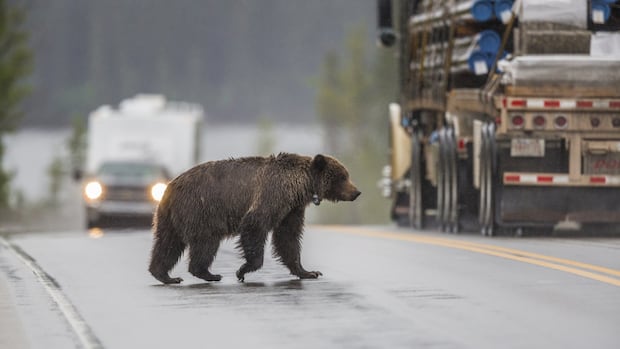A new study found that grizzly bears have had to change their movements across the Canadian Rockies, becoming more constrained over time as they avoid human development like coal mines, highways, large reservoirs and towns.
Analyzing 20 years worth of GPS collar data from over 100 grizzly bears, the research, published in Conservation Science and Practice, found that humans have had a significant impact on the way bears move across an 85,000 square kilometre landscape in southern B.C. and Alberta.
“There already has been quite a bit of connectivity loss for grizzly bears in the southern Canadian Rocky Mountains,” said Eric Palm, the study’s lead author and a postdoctoral researcher at the University of Montana.
Any new coal mines, towns or highway roads would create more barriers for grizzly bears to move around and find food, he said — potentially having bigger ramifications down the road.
“Since that baseline is already pretty high, any additional losses could eventually have population-level effects for grizzly bears,” he said.
In January, the province lifted a moratorium on coal mining in the eastern slopes of the Rocky Mountains, opening the door for suspended projects to resume.
More human development on the horizon — like new and resuming coal mine projects — could further threaten bear habitats, Palm said.
“In B.C. and Alberta there are a lot of proposed coal mine expansions of existing mines, and then there are also some new mines that are being proposed,” he said.
“Building new coal mines in each one of these areas … expands the footprint of human infrastructure [which] can affect connectivity by usually inhibiting animals moving from one habitat patch to another.”
Looking for food, finding trouble
Using computer simulations to predict how more development will impact bears in the future, the study found that those habitat patches would be further disconnected, restricting movement.
Palm explained that grizzly bears in the Canadian Rockies rarely venture out into the prairies, staying confined to the mountains. But there, bears are more constrained, as humans typically develop infrastructure in valley bottoms where some food sources thrive.
The researchers found that when food was scarce, both male and female bears risked coming closer to roads to search for it with forest along roadsides being home to attractive foods such as grasses, flowering plants and buffaloberries.

Tal Avgar, a wildlife ecologist and assistant professor at the University of British Columbia who contributed to the study, said a “grizzly bear that wants to live a long and happy life needs to avoid humans as much as possible.”
The most recent count in Alberta shows 235 grizzly bear mortalities were caused by humans in the period between 2013 and 2022. Most known grizzly bear deaths in the province are caused by humans.
In May, two female grizzly bears were killed by trains in separate incidents in Banff National Park.
“Sometimes humans are associated with where the food is, but in general, we know that bears would like to avoid being close to humans. They would like to avoid being on infrastructure used by humans,” Avgar said.
A potential threat to bear populations
“If genes are being inhibited from flowing from one area… eventually some of these populations could become more isolated from each other,” Palm speculated.
Though this study was limited in scope to the data on grizzly movements, Palm said there was room to further research the potential for new infrastructure to limit not just the bears’ mobility, but also how that could impact their breeding.
Although the threat of new development is concerning, Palm said much work is being done to help increase habitat connectivity in the Rockies, such as wildlife crossings over or under roads that help animals move across human infrastructure.

“Now there is a lot of vulnerability between different species and how much they adopt using these crossings, and sometimes these crossings are very successful, and sometimes less so,” Avgar said.
While wildlife crossings are still helpful in building habitat connections, Avgar said, that solution is limited to roads.
“There are definitely situations where we can’t actually provide those crossing structures [such as] human settlement or a mine,” he said. “We can’t build a bridge above it. It’s an area that the bears are going to avoid to some extent.
“The main thing that we need to keep in mind is that when we plan development, we want to plan it at the large landscape scale, keeping in mind that we still allow populations of animals to move across that landscape, and if we blocked one path, maybe leave other paths open for future development.”







